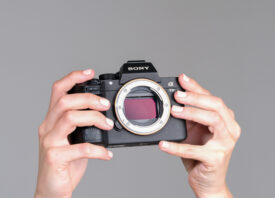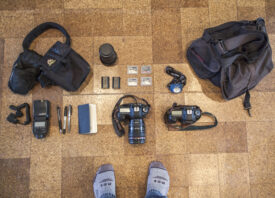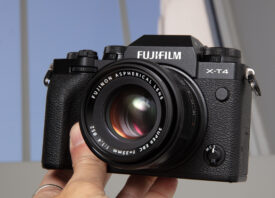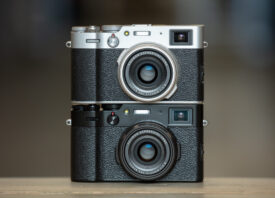Search this site
Photography on a Budget: How to Build Your Kit with Used Gear (Sponsored)
When the now-iconic Canon 5D Classic was released in 2005, it made full-frame digital photography more accessible than ever before. For pros and passionate amateurs alike, it became the camera of choice for high-quality photography on a budget. But perhaps the best thing about the Canon 5D Classic is that it was built to last: 18 years after it was first released, photographers still swear by this camera in 2023.
Right now, you can get a Canon 5D Classic on MPB—the largest platform for used photo gear—for less than $150. If you want a significant upgrade (and low-light performance), you can get its most recent successor, the Canon 5D Mark IV for just under $700 (it costs $2,499 new). If you prefer the latest and greatest in mirrorless tech (and have the budget for it), MPB has dozens of used Canon R5 cameras too.
With so many options available at every price point—from the tried-and-true to the cutting-edge—buying used is a no-brainer. In this guide, we’ve simplified the process by getting back to the basics and finding the perfect blend of quality and affordability. With insights on the best-selling gear of last year at MPB to help guide your choices, here are our best tips for making the most of your budget.

Mirrorless or DSLR?
When building your kit, one of the first decisions you’ll make is your camera —and whether it’s a classic DSLR or a newer mirrorless body with all the bells and whistles. Mirrorless cameras offer several benefits:
- Many of them have stellar autofocus and tracking capabilities.
- They use electronic viewfinders, which means you can see your exposure adjustments in real-time and make changes as you go.
- Leading camera manufacturers are moving away from DSLRs and betting their futures on mirrorless tech.
- As manufacturers invest in mirrorless, the lenses are getting better and better. At the same time, you can still use your old DSLR lenses with a mirrorless camera if you wish—you just need an adapter.
With that said, used DSLRs are still in demand: among the top ten cameras sold by MPB last year, seven were DSLRs. These cameras are especially attractive if you’re shooting photography on a budget: these days, you can get some of the world’s best for a song.
When buying a camera, always get a warranty. (MPB offers a six-month limited warranty on all products.)
All-rounder lenses
Your lenses could prove even more important than your camera body, so it’s important to tailor your choices to your genre and niche. Prime lenses are best for image quality, while zooms offer more flexibility. Weigh what you need—and what you’re willing to sacrifice.
The best starter lens is usually a “nifty-fifty” prime lens. With wide apertures, these lenses offer beautiful bokeh and background separation for portrait photographers. Along with 35mm lenses, 50mm lenses are also popular among street photographers.


The Canon EF 50mm f/1.8 STM lens (for DSLR) was the number one lens sold by MPB in 2022, and the Nikon AF-S Nikkor 50mm f/1.8G lens (also for DSLR) came in at number nine. If you shoot mirrorless, try the Canon RF 50mm f/1.8 STM lens or the Nikon Nikkor Z 50mm f/1.8 S lens. Even the most expensive of these (the last one) is available for under $500, and most are available for much less (starting at $39).

If you’re looking for convenience and versatility, you can’t go wrong with a standard zoom. Professionals swear by high-quality (but relatively pricey) 24-70mm f/2.8 lenses—like this beauty—but if you only get one lens, the larger investment might be worth it to you. Many pros will also recommend opting for a cheaper camera body so you can save for great lenses.
For the more budget-conscious, MPB also has a Tamron SP 24-70mm f/2.8 Di VC USD lens in good condition available for a little under $600.

If you’re interested in something (much) more budget-friendly, you might try something like the Canon EF 24-105mm f/4 L IS USM lens, which came in at number six among the most-sold lenses at MPB last year. These start at $199.

What about lighting?
Natural light plus reflectors and bounce cards will go a long way when shooting photography on a budget, but if you want something extra, start with a speedlight. They’re not as powerful as strobes, but they are convenient and portable. When shooting, use a light stand, and try bouncing the flash off the wall or ceiling (or into an umbrella) for softer lighting.
Tips for Buying Used Gear
It might go without saying, but it’s best to purchase gear from an established, trusted seller with an inspection process—such as MPB—rather than a marketplace, where you’re dealing with individuals who may or may not be honest about the condition of their gear (or know how to inspect it properly).

Choose your platform wisely. The larger the platform, the more options you’ll have—and MPB is the largest of its kind. They recirculate 485,000 items of gear every year. While casually browsing today, I happened to come across the rare Canon 200mm f/1.8 lens, nicknamed the Eye of Sauron.
Only 8,000 of these stunners were ever produced, and they rarely crop up on online marketplaces. When they do, they usually cost $5,000+. Long story short: MPB has not one but two Eyes of Sauron in stock, as of this writing. One of them is listed for just $2,649. That’s not something you can find just anywhere.

Trade before buying. If you’re building a photography kit on a budget, consider trading your old gear rather than simply buying something new. According to research conducted by MPB a few years back, 55% of photographers in the UK have gear they haven’t used in two years, while 65% have equipment they haven’t used in a year.
If you’re not using your camera (or extra lenses), trade it in and get something you will use. On average, MPB customers earn $900 each time they sell.
Be thorough. When buying used, do your research. MPB’s inspection process is extremely detailed, and each item is individually photographed so you know exactly what you’re getting. On cameras with a physical shutter mechanism, such as DSLRs, they’ll even provide a shutter count when possible.
Take great care of your gear. After investing, you’ll want to do everything you can to ensure you protect the resale value of your gear for when you’re ready to trade it in for something else. Mold can be a huge problem, so beware of any moisture, and keep your gear in places where the air circulates well (no tiny closets).
Give your equipment gentle but regular checks and cleanings to ensure everything’s working as it should (sensors should only be cleaned by pros). Finally, keep everything that arrived in the box when you ordered your camera from MPB—these can help you get a better price when the time comes to upgrade.

This article was sponsored by MPB.
Learn more about shooting photography on a budget:
- Sustainable Photography Means Not Buying New Gear
- MPB Can Help You Earn Money & Upgrade Your Camera Gear
- If You Own One of These Cameras, Now Is The Time To Sell It
- The Best MPB Used Cameras for Street Photography
- The Top 10 Best Used Cameras for Landscape Photography
To learn more about how MPB protects you when buying or selling used camera gear online, check out our article on how to avoid scammers.




